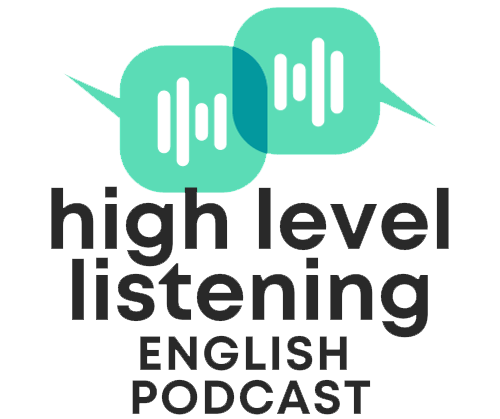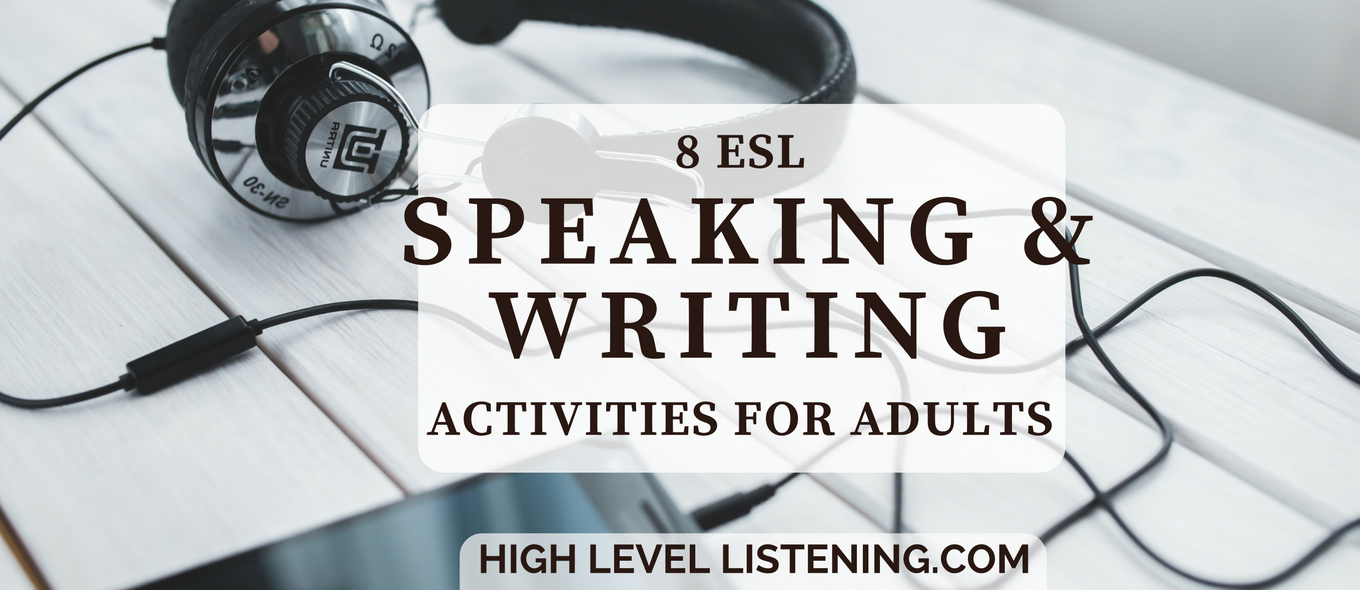Teaching ESL to adults can be difficult without the right materials for both traditional classroom teachers and for those who teach English online. If you want your students to practice listening to naturally spoken English, like they would learn in the real world, then you’ve come to the right place with our 8 ESL Speaking and Writing Activities for Adults.
All the images and activities you can see in the post are taken from our English Work Series Package, which are 5 x 60+ minute ESL Vocabulary Lesson Plans for advanced students and adults
25 MP3s + Transcripts + Speaking & Writing Exercises + Expressions & Vocabulary + Teacher Answer Key
[selz link=”http://selz.co/4k8f6Vz2f” show_logos=”false” background_color=”#6d48cc” text_color=”#ffffff” link_color=”#6d48cc” chbg_color=”#6d48cc” chtx_color=”#ffffff” type=”widget” interact=”modal”]
English Lesson Plans for Adults
- Speaking Exercises
- Creating Your Own Definitions
- Mimicking
- Discussion
- Making Questions
- Reported Speech
- Writing Exercises
- Role Plays
- Paraphrasing
Speaking Exercises:
Create Collocations
This is ideal for pair and group work, and it’s a great warm-up before you listen to the audio.
Sometimes, your students learn a new word, but they don’t know how to use it. Practicing collocations helps the students put their new advanced vocabulary into use right away.
Try asking your students these questions when introducing them to new vocab:
Where can you use this word/phrase?
Who are you talking to when you use this?
In what situations can you use this phrase?
What are some synonyms for this word?
For example, in our Work Vocabulary Day 1, we looked at ‘Perks’. But remember, we can use perks to describe any positive addition to almost any environment, from shopping, to school, to holidays, not only in jobs and business! So you can get your students’ brains working with this:
Pre-Listening Conversation Activity
Write down some of some different categories, and then ask your students to think of some perks about each one: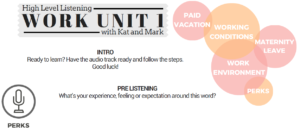
Holidays – Breakfast included – Free pick-ups from the airport
Shopping – Buy one get one free – Lifetime warranty on new products
School – Access to the school library – Student discounts on software
Create your Own Definitions
We always encourage our students to create their own definitions and example sentences. When students apply their own experiences to a word, it gives them a unique and personal context to associate with it. All of this does wonders for their memory too.
For example: Work Vocabulary Day 5 – ‘Cushy Job’
Listen to the audio, then ask your students to define a ‘Cushy Job’. Then discuss as a class and listen to each other’s definitions – writing down any answers that are especially useful.
Student Answer: “An easy job, but with a decent salary. A job with little responsibility. A low-pressure or a comfortable job. Something good and bad, it depends on the individual.”
Next, ask your students to write an example sentence from their own experience. For example:
Student’s personal example: “I think my uncle has a cushy job working for the police in a quiet village in the countryside.”
Mimicking
You’d be surprised at how good listening practice is for speaking practice. Especially when it comes to contractions, which are the biggest and most difficult differences between written and spoken English.
Particular 3-word groups like ‘A lot of’ or ‘Some of the’ are spoken very quickly. When you hear them, try to pause the audio, listen carefully to how we say it, then practice. You can even encourage them to write down their own phonetic spellings:
A lot of = ‘Allottov’ / Some of the = ‘Someuhthe’ / One of the = ‘Oneuhthe’
They might sound a bit silly on their own, so ask your students to make their own sentences and read them in full. We guarantee you’ll hear an impressive leap forward in their perceived fluency.
A lot of little words get lost in native sentences – especially ‘To’.
For example, in Work Vocabulary Day 2 – ‘Volunteer Work’, listen to Kat’s line at [0:15]: ‘I haven’t really had any time to do any volunteer work.’ and Mark’s line at [0:45]: ‘I gave up my mornings to go into the ESL academy’.
Because the ‘to’ is next to a verb, native English speakers say: ‘t’do’ and ‘t’go’. Practice this with your students, and they’ll be sounding like native speakers in no time!
Discuss
There’s so much to discuss with each and every audio clip. In pairs or groups, ask opinion-based questions about each topic – get your students thinking, or even a small debate going.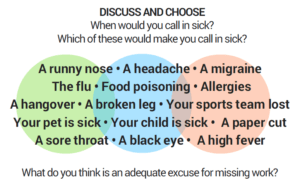
Here are a few examples:
Work Day 3 – Call In Sick:
“What do you think is an adequate excuse to call in sick? Why?”
Work Day 3 – Dead-End Job:
“Why do you think some people stay in dead-end jobs?”
“How do people end up in dead-end jobs?”
Make Questions
After a quick discussion, give your students the chance to make their own questions! Students can ask each other in their groups, or if they’re having a hard time, create questions as a class. Being able to ask questions about different topics can give your students the confidence to join a whole range of discussions. As well as ask their teacher for more information when they need it. We’ve had great success with these techniques with students of all levels.
Practice Reported Speech
Reported Speech is hard. Even for teachers, mainly because you need at least 3 speakers for it to make sense.
HLL to the rescue!
Pause the audio file after a certain sentence, and ask:
“What did he/ she say?”
“What did Kat ask Mark?”
“How did he / she describe __________________?”
A specific example from Work Day 1 – Work Environment:
“How did Mark describe the work environment at this last job?”
Example answer: “He said he had a very healthy work environment, because no one was afraid to suggest new ideas or try something new.”
These recordings are excellent context for this difficult advanced English grammar point. Whether you want to introduce or refresh your students’ reported speech skills, this is a great way to do it.
Writing Exercises
Writing Role Plays
Perfect for practising their new vocabulary. This is also a great task for homework, allowing your students to flex their muscles and tie in all their knowledge around a given topic.
Here are some examples:
Work Day 4 – Getting Fired – “Write about why your colleague / co-worker got fired. What did they do? Do you think they deserved it?”
Work Day 4 – Quit – “You finally had enough and yesterday you quit your job. Write a message to a close friend telling them why you quit and how you did it – and mention how you feel about it now. Are you relieved or do you regret your decision?”
Paraphrase
Pick a sentence, listen to it a few times, or write it down, and have the students repeat the sentence in their own words – in pairs or groups. Paraphrasing is a very effective way of putting synonyms and alternative expressions to work. You’ll be amazed how many different variations you can get from this exercise. 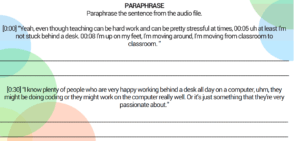
Here’s a few examples:
Work Day 3 – Stuck Behind A Desk:
[Transcript] Mark: [0:00] “Yeah, even though teaching can be hard work and can be pretty stressful at times, uh at least I’m not stuck behind a desk. I’m up on my feet, I’m moving around, I’m moving from classroom to classroom.
Student Paraphrase:
“Teaching isn’t always easy, but I’m glad I’m not stuck behind a desk because I like being active.”
“Although teaching can be a difficult and stressful job, I would prefer that instead of being stuck behind a desk.”
[Transcript] Kat: [0:30] “I know plenty of people who are very happy working behind a desk all day on a computer, uhm, they might be doing coding or they might work on the computer really well. Or it’s just something that they’re very passionate about.”
Student Paraphrase:
“Even if it’s just working on a computer, if someone loves what they do, then they won’t feel stuck behind a desk.”
“There are some workers who don’t mind doing a repetitive job or a simple job, especially if they really enjoy the work.”
So there you have it! 8 ESL conversation and writing activities for adults with HLL in your classroom! We hope these tips help you extract all the goodness from every single one of our audio clips!
But, we know what you’re thinking…
Wouldn’t it be wonderful it someone had already created 5 x 60+ minute lesson plans containing worksheets with all the exercises featured in this post (and more), including all 25 MP3s, with full transcripts, separate teacher and student PDFs, with gap-fill exercises and review quizzes too?
Funny you should mention, that’s exactly what we did! You can buy 5 x 60+ minute lessons based on our Work Series audio clips on HighLevelListening.com for just $5.00!
[selz link=”http://selz.co/4k8f6Vz2f” show_logos=”true” background_color=”#6d48cc” text_color=”#ffffff” link_color=”#6d48cc” chbg_color=”#6d48cc” chtx_color=”#ffffff” type=”widget” interact=”modal”]
Happy teaching!
